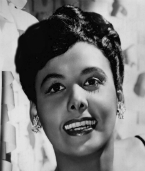 American Jazz Singer. Film Actress. Dancer. Civil Rights Activist. Those are just a few of the titles attributed to the late Lena Horne. Born in Brooklyn, New York in June of 1917, by the age of sixteen she was hired as a chorus girl at Harlem’s Cotton Club, performing with Adelaide Hall in ‘Cotton Club Parade’ in 1934. Following her stint at the Cotton Club, Horne was hired as the female vocalist in Noble Sissles’ Orchestra, where she recorded some of her first records on the Decca label. Charlie Barnet heard one of her recordings and invited Horne to join his band in 1940, but she quickly tired of the travel and soon returned to New York to perform at the Café Society.
American Jazz Singer. Film Actress. Dancer. Civil Rights Activist. Those are just a few of the titles attributed to the late Lena Horne. Born in Brooklyn, New York in June of 1917, by the age of sixteen she was hired as a chorus girl at Harlem’s Cotton Club, performing with Adelaide Hall in ‘Cotton Club Parade’ in 1934. Following her stint at the Cotton Club, Horne was hired as the female vocalist in Noble Sissles’ Orchestra, where she recorded some of her first records on the Decca label. Charlie Barnet heard one of her recordings and invited Horne to join his band in 1940, but she quickly tired of the travel and soon returned to New York to perform at the Café Society.
By 1941, Lena Horne’s popularly had gown to the point that she was hired as a replacement on NBC radio’s popular show ‘The Chamber Music Society of Lower Basin Street’ when Dinah Shore left the program. She was with the broadcast for six months when the owner of the Trocadero Club in Los Angeles invited Lena out west to star in a Cotton Club-style musical review.
By the time World War Two broke out, Hollywood had become her new home, where she obtained small parts in a variety of movies before she landed larger roles in such films as ‘Cabin in the Sky’, ‘Panama Hattie’ and ‘Stormy Weather’. By then, Horne had already appeared a couple of low-budget films including a soundie short (the 1940’s equivalent of today’s music videos) called ‘Boogie Woogie Dream’, co-starring pianists Pete Johnson and Albert Ammons.
In November of 1944, Horne was featured in an episode of the popular radio series ‘Suspense’ as a fictional nightclub singer. After the war, Horne traveled with the Billy Eckstine Orchestra for a time. In 1946 she returned to the MGM lot to film ‘Zigfield Follies’, where she performed “Love”. Horne sought after the role of Julie LaVerne in MGM’s 1951 version of ‘Show Boat’ (having already played the role when a segment of ‘Show Boat’ was performed in ‘Till the Clouds Roll By’), but lost the part to Ava Gardner.
Throughout her film career, Horne often lost roles because she was African American. Sadly, most of Horne’s film appearances were brief, with the notable exception of the all-black musical ‘Cabin in the Sky’, although a number from that film was cut before release because it was considered “too suggestive” by film censors.
Lena Horne was blacklisted for a time during the 1950s for her alleged affiliations in the 1940s with communist groups. She would subsequently disavow communism. She was the first African-American elected to serve on the Screen Actors Guild board of directors.
Horne was involved with the civil rights movement going back to the war years, when while entertaining troops for the USO, she refused to perform for segregated audiences in which German prisoners of war were seated in front of African American servicemen. She also worked with Eleanor Roosevelt to pass anti-lynching laws and was present at Martin Luther King’s March on Washington.
By the mid-1950s, Lena Horne grew weary of Hollywood and began to focus once again on her nightclub career. She headlined at clubs and hotels throughout North America and Europe, with multi-week engagements at Las Vegas’s Sands Hotel (where Sinatra and the ‘Rat Pack’ often appeared), along with the world famous Cocoanut Grove inside the Ambassador Hotel in Los Angeles and New York’s Waldorf-Astoria Hotel. In 1957, a live album titled ‘Lena Horne at the Waldorf’ soon became the biggest-selling record by a female artist in the history of RCA Records. In 1958, Horne became the first African-American woman to be nominated for a Tony Award for her part in the musical ‘Jamaica’, co-starring fellow performer from her Cotton Club days, Adelaide Hall.
From the 1950s through the 1970s, Horne appeared on a number of television variety shows. She announced her retirement in March 1980, but the next year starred in a one-woman show, ‘Lena Horne: The Lady & Her Music’, which continued on Broadway for more than three hundred sold-out performances. The show holds to this day the record for the longest-running solo performance in Broadway history. Horne continued recording and performing every now and again into the 1990s, finally retiring altogether in 2000. Horne died of congestive heart failure on May 9, 2010, at the age of 92.
